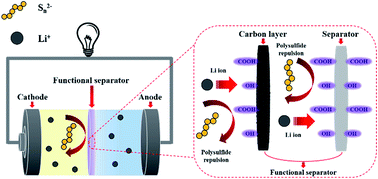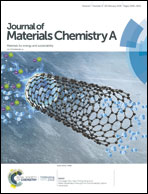Plasma-functionalized carbon-layered separators for improved performance of lithium sulfur batteries†
Abstract
Lithium–sulfur (Li–S) batteries are one of the most promising next generation secondary batteries due to high energy capacity and low cost. However, they suffer from the loss of active material, insulating nature of sulfur, degradation of the lithium anode and fast capacity fading due to polysulfide shuttling. In this work, a novel approach has been made to improve the performance of the Li–S battery by using functional separators that are modified using a plasma technique. The plasma-modified functional separator is made by firstly irradiating a polymer separator with a plasma, secondly followed by coating it with a thin carbon layer which is then thirdly subjected to an additional plasma treatment to modify the carbon layer. The plasma treatment generates various functional groups on the surfaces of the polymer separator and the carbon layer. The plasma-modified functional separator is found to provide more wettability, electric conduction paths and active sites that could facilitate the redox reactions and lithium ion transport as well as reduce the polysulfide shuttling, ultimately leading to a dramatic improvement in the performance of the Li–S battery. Among various plasma gases tested, such as CO2, N2 and O2, the CO2 plasma is found to be the most effective in improving the electrochemical properties of the functional separators. The polysulfide permeation rate through the CO2-plasma-modified functional separator is reduced by about 70 times and the Li–S battery employing the functional separator displays an initial capacity of 1204 mA h g−1 and a remaining capacity of 802 mA h g−1 after 100 cycles at 0.2C rate, which account for 57% and 61% increments, respectively, as compared with those of the cell using a pristine separator. In-depth physicochemical and electrochemical analyses have also been carried out to characterize the modified separators and carbon layers and to interpret the reasons for the improved performance of the Li–S batteries employing the functional separators. Accordingly, these functional separators modified with plasma are confirmed to be very promising for the development of high performance Li–S batteries.



 Please wait while we load your content...
Please wait while we load your content...